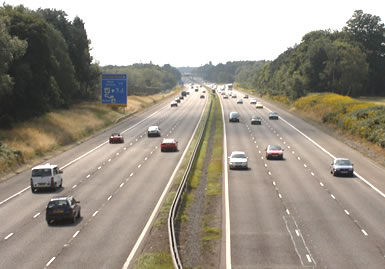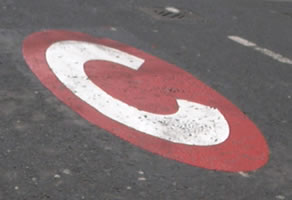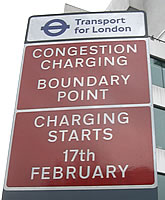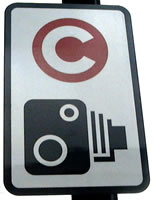|
|
Study, work or travel in the UK. British
culture and life.
|
|
|
|
|
|
|
|
|
|
|
|
|
|
|
|
|
|
|
|
|
|
|
|
|
|
|
|
|
|
|
|
|
|
| |
|
|
|
|
|
|
|
|
|
Drive a car in the UK or Europe
|
INTRODUCTION
You may want to buy a car in the UK if you do not live close to your place
of work or study, although you might first consider using public transport if
it is available. Driving in the UK can be expensive: for example, taxes on petrol
are very high. Most students, and many people who live in major cities such as
London, do not own a car.
To explore the British countryside, some people want to hire a car, because
some areas are not served by frequent train and bus services.
For information about sharing a car journey, see: http://www.liftshare.org
Some notes about driving in the UK are available from the Visit Britain's
site: http://www.visitbritain.com/world/fact_files/travel/in_britain/driving.htm
Back to top
DRIVING LICENCE
You must not drive unless you have a driving licence which is valid in
the UK. There are different rules for people holding licences from other countries:
you should check requirements before you travel to the UK. The rules are summarised
in the UKCISA guidance notes on "Driving in Great Britain: a guide for international
students", see: http://www.ukcisa.org.uk/student/information_sheets.php.
Licences issued in other EEA
(European Economic Area) countries can normally be used within the UK. If you
come from outside the EEA, you may be able to drive for up to 12 months if you
obtain an international driving permit before coming to the UK, or if you are
already in the UK you may be able to exchange the licence obtained in your country
for a British one (Japanese students may need to obtain an official translation
from their embassy). If you are frm outside the EEA and you stay in the UK for
more than 12 months, you will normally need to take a driving test to obtain a
UK driving licence.
For further information, see the website of the DVLA (Driver and Vehicle Licensing
Agency): http://www.dvla.gov.uk.
Back to top
CAR RENTAL OR SHARING
You can find a car rental company using UpMyStreet at http://www.upmystreet.com.
Enter your postcode, go to the Find My Nearest … section and choose
Motors then Self drive then Car rental. The companies which
are closest will be listed first.
There is a car-share agency Freewheelers which will try to match you with
a car driver who is travelling to your destination. This may help the environment
and can save you money, but if you use this kind of service you should be careful
about your personal safety. For details, see: http://www.freewheelers.co.uk
Back to top
JOURNEY PLANNING
A lot of useful information for drivers, including information on car breakdowns
and finding your way, is contained on the websites of the two main British motorist
organisations:
The RAC: http://www.rac.co.uk
The AA: http://www.theaa.com
Back to top
PARKING
Car parks
You can find a car park using UpMyStreet at http://www.upmystreet.com.
Enter your postcode, go to the Find My Nearest … section and choose
Motors then Car parking & garaging. The car parks which are
closest will be listed first.
Roadside parking
You cannot park your car on a road which has double yellow lines or double
red lines (two yellow or red lines along the side of the road). If there
is a single yellow line, parking may be allowed at some times (there
will be a sign nearby explaining the rules). In many residential areas in the
centre of cities, parking may be for local residents only, or you may need to
display a parking permit on your windscreen. Some areas have parking meters,
which allow you to pay to park there for a short time (for example: 2 hours).
You are not supposed to keep adding money to a parking meter to stay for a longer
time, although some people do this.
Parking fines
Traffic wardens often check that parking rules are being followed. If you are
breaking the rules, you may be given a parking fine. In some cases your car
may be wheel-clamped, which means that large locks will be added to the
wheels of your car. You have to pay a fine and arrange for the wheel-clamp to
be removed (a process that may take several hours) before you can drive your
car away.
Back to top
ROAD RULES
In the UK cars drive on the left-hand side of the road, and the steering-wheel
in cars in therefore on the right-hand side. Although it is allowed to drive a
car in which the steering-wheel is on the left, you should be very careful if
you do this.
If there is a pedestrian crossing across the road (marked using black and
white stripes across the road, and round orange lights on either side of the road),
you must stop your car if someone is wanting to cross. Similar types of crossing
which are controlled with traffic lights (which change after a pedestrian has
pressed a button) are known as pelican crossings.
[ information about roundabouts to be added ]
 Motorway driving
Motorway driving |
There is quite an extensive system of motorways which usually
allow you to travel quickly between major cities (the ones around London
can be very busy). Most have three main lanes, plus a lane on the left
(known as the hard shoulder) where you can stop in an emergency.
The speed limit is usually 70 miles per hour, although lower limits are
sometimes shown using signs above the road. The lane on the left is the
slowest lane, and is often used by large vehicles or smaller cars with
less powerful engines. The lane on the right is supposed to be used only
for overtaking - you should move back to a slower lane as soon as possible.
There are tolls (charges) for crossing some bridges, but there are usually
no motorway charges in the UK.
|
The Highway Code sets out the rules for driving in the UK. If you take
a driving test in the UK you will be asked questions about these rules. If you
have an international driving licence you may still want to review this book before
driving in the UK.
Back to top
DRIVING IN CENTRAL LONDON
Roads in central London are very busy, driving can be very slow, and parking can
be difficult and expensive. It can also be quite complicated to find your way
around if you do not know the roads. Try to avoid taking a car into central London
and use public transport instead (for details of London Transport, see: Travel/Transport/London;
for details of train travel into London, see: Travel/Transport/Train;
for details of how to use taxis, see: Travel/Transport/Taxi).
Congestion charging was introduced in central London in February 2003.
If you drive within the Central London congestion charging zone between
7am and 6pm (before February 2007 it was 6:30pm) between Monday and Friday (except
on public holidays and during the period between Christmas and New Year), you
need to pay the daily charge (from 4 July 2005 this is £8) before midnight
on the same day. You can pay at many newsagents, shops, petrol stations or car
parks, or by telephone or on the internet (assuming that you have a credit card
or debit card). You can also pay on the next charging day (if you drove into the
zone on Friday, this would be the following Monday) using the website or call
centre only, but the charge rises (from 4 July 2005 this is £10). If you
do not pay before the end of the following day and the roadside cameras have photographed
your car's numberplate, you will be sent a Penalty Charge Notice and will
have to pay much more (£100, reduced to £50 if paid within 2 weeks
or increased to £150 if not paid within a month). There are no road barriers,
but you will know that you have entered the charging zone when you pass signs
like those shown below. For details, see: http://www.cclondon.com.
From 19 February 2007 the congestion charging zone is being extended further to
the west, to include most of Pimlico, Belgravia, Brompton, Knightsbridge, Bayswater,
South Kensington, Kensington, Notting Hill and North Kensington. A few roads passing
through the new extended zone will not have a charge: these are the roads on the
western side of the previous congestion zone (Edgware Road, Park Lane, Grosvenor
Place, Vauxhall Bridge Road) and the A40 (Westway). Note that if you live within
the charging zone (or in some neighbouring areas) you can obtain a residents'
discount. The western extension of the congestion zone will
be scrapped in 2010.
Back to top
DRIVING IN EUROPE
To find out details of car ferry services from the UK to Europe, see: Travel/Transport/Ferry.
Eurotunnel carries passengers and cars between Folkestone (UK) and Calais
(France): http://www.eurotunnel.co.uk.
The train is called Le Shuttle. The journey (through the Channel Tunnel) takes
about 35 minutes.
Back to top
LINKS
Motor sports: Life/Sport/Motor
Ferries: Travel/Transport/Ferry
London-Brighton Veteran Car Run: Ideas/Album/VeteranCarRun
Home page: Home
Back to top
© UK Student Life 2002-2009
* Search this website (www.ukstudentlife.com) or the web:









